Nursing Diploma: HLTAAP002/HLTAAP003 Case Study 2 - Health Analysis
VerifiedAdded on 2023/03/29
|9
|3488
|150
Case Study
AI Summary
This nursing case study assignment focuses on analyzing client health information across three different scenarios: endocrine, integumentary, and neurovascular disorders (Percy Jones); neurological and urinary disorders (Lee Ming); and respiratory, genetic, and reproductive disorders (Madeleine Brown). The assignment requires students to answer specific questions related to each case, demonstrating their understanding of disease pathophysiology, risk factors, diagnostic interpretation, and interprofessional collaboration. For Percy Jones, questions address diabetes type 2, leg ulcers, hypoglycemia, and wound care. For Lee Ming, the focus is on urinary tract infections, elevated temperature, TIA, CVA, and embolic CVA. For Madeleine Brown, the case explores cystic fibrosis, its impact on the respiratory system, and genetic inheritance patterns. The assignment assesses the student's ability to apply theoretical knowledge to practical clinical scenarios and to identify appropriate healthcare professionals involved in patient care. Desklib provides a platform for students to access similar solved assignments and past papers to aid in their studies.
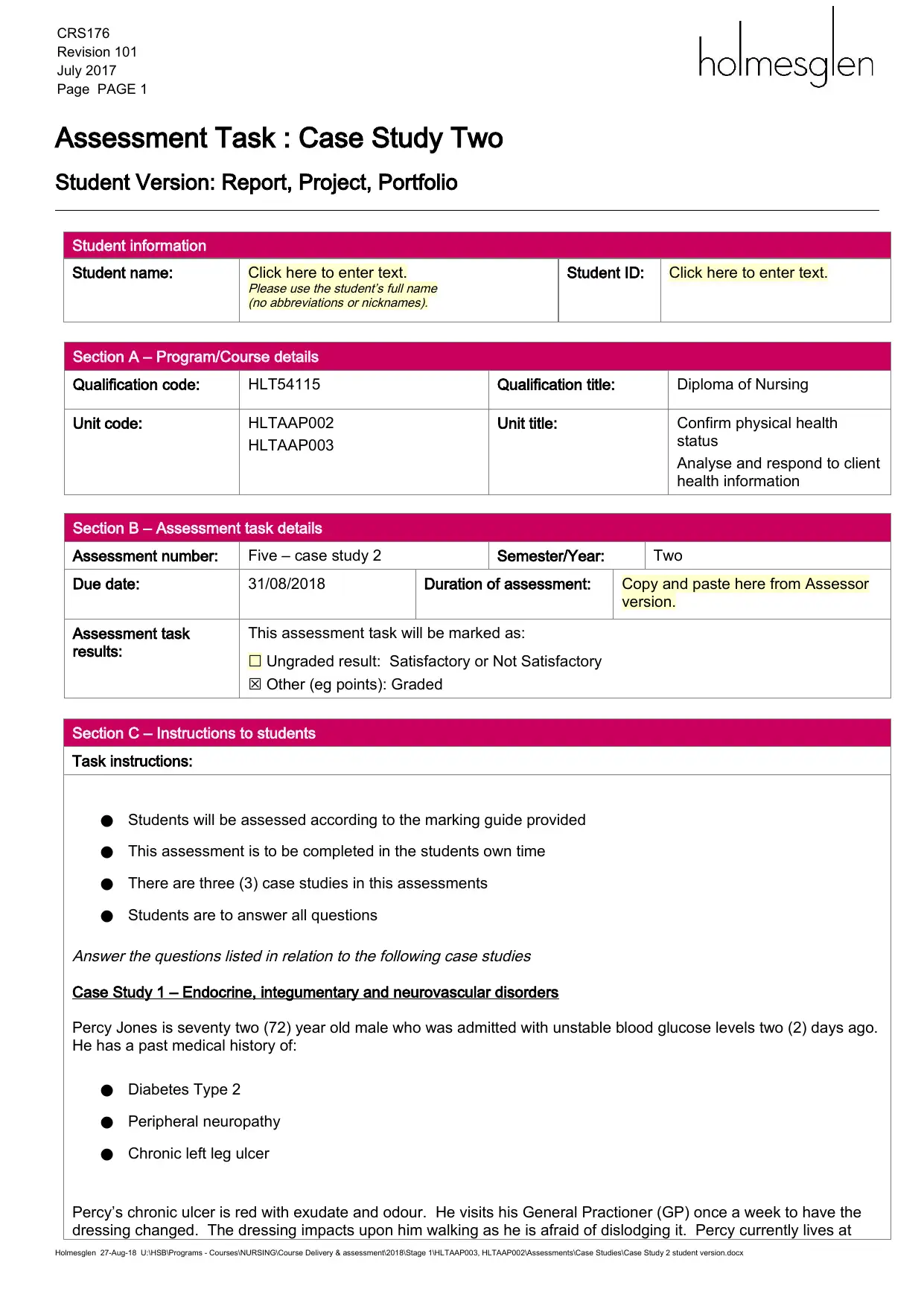
CRS176
Revision 101
July 2017
Page PAGE 1
of NUMPAGES
Assessment Task : Case Study Two
Student Version: Report, Project, Portfolio
Student information
Student name: Click here to enter text.
Please use the student’s full name
(no abbreviations or nicknames).
Student ID: Click here to enter text.
Section A – Program/Course details
Qualification code: HLT54115 Qualification title: Diploma of Nursing
Unit code: HLTAAP002
HLTAAP003
Unit title: Confirm physical health
status
Analyse and respond to client
health information
Section B – Assessment task details
Assessment number: Five – case study 2 Semester/Year: Two
Due date: 31/08/2018 Duration of assessment: Copy and paste here from Assessor
version.
Assessment task
results:
This assessment task will be marked as:
☐ Ungraded result: Satisfactory or Not Satisfactory
☒ Other (eg points): Graded
Section C – Instructions to students
Task instructions:
● Students will be assessed according to the marking guide provided
● This assessment is to be completed in the students own time
● There are three (3) case studies in this assessments
● Students are to answer all questions
Answer the questions listed in relation to the following case studies
Case Study 1 – Endocrine, integumentary and neurovascular disorders
Percy Jones is seventy two (72) year old male who was admitted with unstable blood glucose levels two (2) days ago.
He has a past medical history of:
● Diabetes Type 2
● Peripheral neuropathy
● Chronic left leg ulcer
Percy’s chronic ulcer is red with exudate and odour. He visits his General Practioner (GP) once a week to have the
dressing changed. The dressing impacts upon him walking as he is afraid of dislodging it. Percy currently lives at
Holmesglen 27-Aug-18 U:\HSB\Programs - Courses\NURSING\Course Delivery & assessment\2018\Stage 1\HLTAAP003, HLTAAP002\Assessments\Case Studies\Case Study 2 student version.docx
Revision 101
July 2017
Page PAGE 1
of NUMPAGES
Assessment Task : Case Study Two
Student Version: Report, Project, Portfolio
Student information
Student name: Click here to enter text.
Please use the student’s full name
(no abbreviations or nicknames).
Student ID: Click here to enter text.
Section A – Program/Course details
Qualification code: HLT54115 Qualification title: Diploma of Nursing
Unit code: HLTAAP002
HLTAAP003
Unit title: Confirm physical health
status
Analyse and respond to client
health information
Section B – Assessment task details
Assessment number: Five – case study 2 Semester/Year: Two
Due date: 31/08/2018 Duration of assessment: Copy and paste here from Assessor
version.
Assessment task
results:
This assessment task will be marked as:
☐ Ungraded result: Satisfactory or Not Satisfactory
☒ Other (eg points): Graded
Section C – Instructions to students
Task instructions:
● Students will be assessed according to the marking guide provided
● This assessment is to be completed in the students own time
● There are three (3) case studies in this assessments
● Students are to answer all questions
Answer the questions listed in relation to the following case studies
Case Study 1 – Endocrine, integumentary and neurovascular disorders
Percy Jones is seventy two (72) year old male who was admitted with unstable blood glucose levels two (2) days ago.
He has a past medical history of:
● Diabetes Type 2
● Peripheral neuropathy
● Chronic left leg ulcer
Percy’s chronic ulcer is red with exudate and odour. He visits his General Practioner (GP) once a week to have the
dressing changed. The dressing impacts upon him walking as he is afraid of dislodging it. Percy currently lives at
Holmesglen 27-Aug-18 U:\HSB\Programs - Courses\NURSING\Course Delivery & assessment\2018\Stage 1\HLTAAP003, HLTAAP002\Assessments\Case Studies\Case Study 2 student version.docx
Paraphrase This Document
Need a fresh take? Get an instant paraphrase of this document with our AI Paraphraser
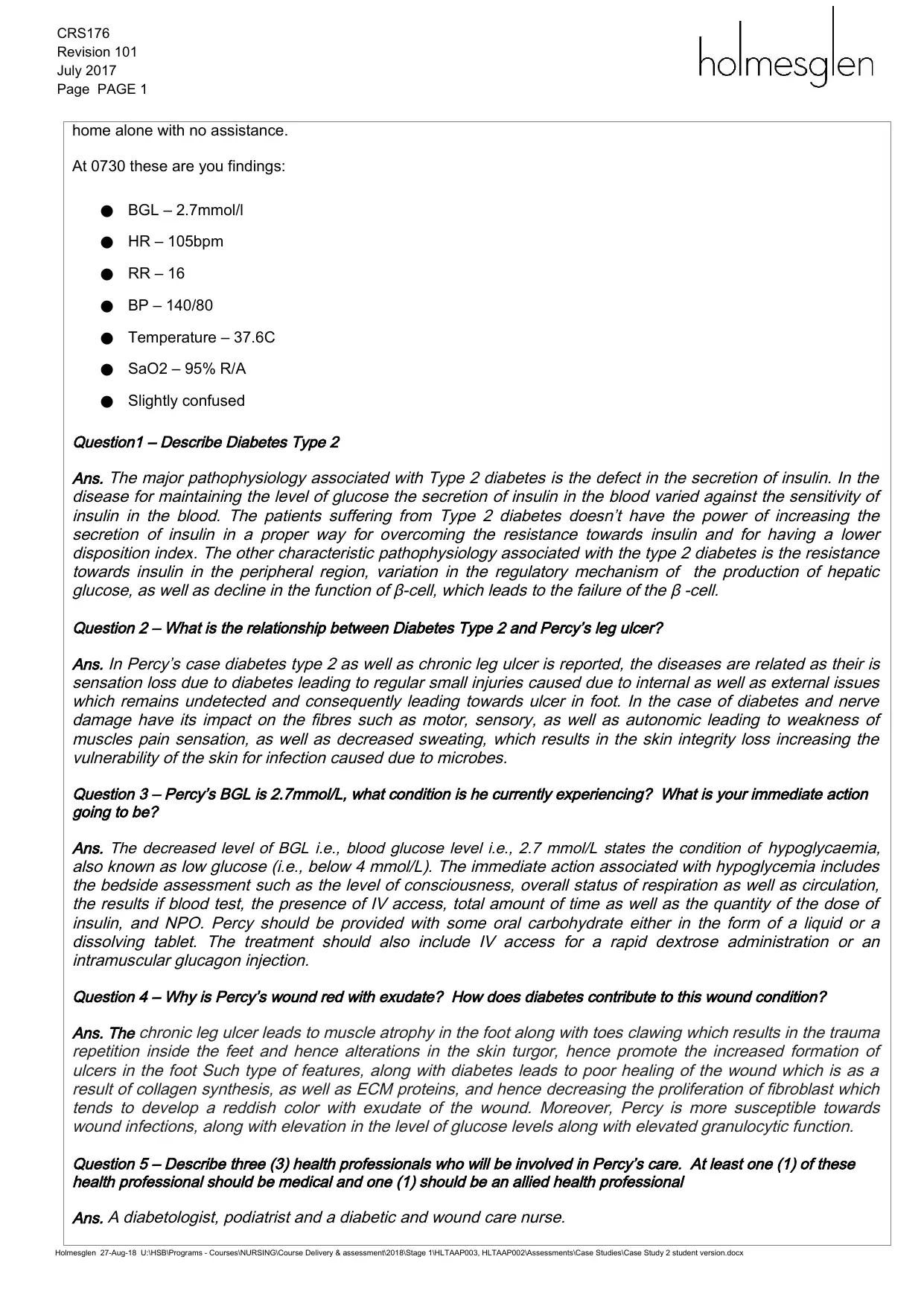
CRS176
Revision 101
July 2017
Page PAGE 1
of NUMPAGES
home alone with no assistance.
At 0730 these are you findings:
● BGL – 2.7mmol/l
● HR – 105bpm
● RR – 16
● BP – 140/80
● Temperature – 37.6C
● SaO2 – 95% R/A
● Slightly confused
Question1 – Describe Diabetes Type 2
Ans. The major pathophysiology associated with Type 2 diabetes is the defect in the secretion of insulin. In the
disease for maintaining the level of glucose the secretion of insulin in the blood varied against the sensitivity of
insulin in the blood. The patients suffering from Type 2 diabetes doesn’t have the power of increasing the
secretion of insulin in a proper way for overcoming the resistance towards insulin and for having a lower
disposition index. The other characteristic pathophysiology associated with the type 2 diabetes is the resistance
towards insulin in the peripheral region, variation in the regulatory mechanism of the production of hepatic
glucose, as well as decline in the function of β-cell, which leads to the failure of the β -cell.
Question 2 – What is the relationship between Diabetes Type 2 and Percy’s leg ulcer?
Ans. In Percy’s case diabetes type 2 as well as chronic leg ulcer is reported, the diseases are related as their is
sensation loss due to diabetes leading to regular small injuries caused due to internal as well as external issues
which remains undetected and consequently leading towards ulcer in foot. In the case of diabetes and nerve
damage have its impact on the fibres such as motor, sensory, as well as autonomic leading to weakness of
muscles pain sensation, as well as decreased sweating, which results in the skin integrity loss increasing the
vulnerability of the skin for infection caused due to microbes.
Question 3 – Percy’s BGL is 2.7mmol/L, what condition is he currently experiencing? What is your immediate action
going to be?
Ans. The decreased level of BGL i.e., blood glucose level i.e., 2.7 mmol/L states the condition of hypoglycaemia,
also known as low glucose (i.e., below 4 mmol/L). The immediate action associated with hypoglycemia includes
the bedside assessment such as the level of consciousness, overall status of respiration as well as circulation,
the results if blood test, the presence of IV access, total amount of time as well as the quantity of the dose of
insulin, and NPO. Percy should be provided with some oral carbohydrate either in the form of a liquid or a
dissolving tablet. The treatment should also include IV access for a rapid dextrose administration or an
intramuscular glucagon injection.
Question 4 – Why is Percy’s wound red with exudate? How does diabetes contribute to this wound condition?
Ans. The chronic leg ulcer leads to muscle atrophy in the foot along with toes clawing which results in the trauma
repetition inside the feet and hence alterations in the skin turgor, hence promote the increased formation of
ulcers in the foot Such type of features, along with diabetes leads to poor healing of the wound which is as a
result of collagen synthesis, as well as ECM proteins, and hence decreasing the proliferation of fibroblast which
tends to develop a reddish color with exudate of the wound. Moreover, Percy is more susceptible towards
wound infections, along with elevation in the level of glucose levels along with elevated granulocytic function.
Question 5 – Describe three (3) health professionals who will be involved in Percy’s care. At least one (1) of these
health professional should be medical and one (1) should be an allied health professional
Ans. A diabetologist, podiatrist and a diabetic and wound care nurse.
Holmesglen 27-Aug-18 U:\HSB\Programs - Courses\NURSING\Course Delivery & assessment\2018\Stage 1\HLTAAP003, HLTAAP002\Assessments\Case Studies\Case Study 2 student version.docx
Revision 101
July 2017
Page PAGE 1
of NUMPAGES
home alone with no assistance.
At 0730 these are you findings:
● BGL – 2.7mmol/l
● HR – 105bpm
● RR – 16
● BP – 140/80
● Temperature – 37.6C
● SaO2 – 95% R/A
● Slightly confused
Question1 – Describe Diabetes Type 2
Ans. The major pathophysiology associated with Type 2 diabetes is the defect in the secretion of insulin. In the
disease for maintaining the level of glucose the secretion of insulin in the blood varied against the sensitivity of
insulin in the blood. The patients suffering from Type 2 diabetes doesn’t have the power of increasing the
secretion of insulin in a proper way for overcoming the resistance towards insulin and for having a lower
disposition index. The other characteristic pathophysiology associated with the type 2 diabetes is the resistance
towards insulin in the peripheral region, variation in the regulatory mechanism of the production of hepatic
glucose, as well as decline in the function of β-cell, which leads to the failure of the β -cell.
Question 2 – What is the relationship between Diabetes Type 2 and Percy’s leg ulcer?
Ans. In Percy’s case diabetes type 2 as well as chronic leg ulcer is reported, the diseases are related as their is
sensation loss due to diabetes leading to regular small injuries caused due to internal as well as external issues
which remains undetected and consequently leading towards ulcer in foot. In the case of diabetes and nerve
damage have its impact on the fibres such as motor, sensory, as well as autonomic leading to weakness of
muscles pain sensation, as well as decreased sweating, which results in the skin integrity loss increasing the
vulnerability of the skin for infection caused due to microbes.
Question 3 – Percy’s BGL is 2.7mmol/L, what condition is he currently experiencing? What is your immediate action
going to be?
Ans. The decreased level of BGL i.e., blood glucose level i.e., 2.7 mmol/L states the condition of hypoglycaemia,
also known as low glucose (i.e., below 4 mmol/L). The immediate action associated with hypoglycemia includes
the bedside assessment such as the level of consciousness, overall status of respiration as well as circulation,
the results if blood test, the presence of IV access, total amount of time as well as the quantity of the dose of
insulin, and NPO. Percy should be provided with some oral carbohydrate either in the form of a liquid or a
dissolving tablet. The treatment should also include IV access for a rapid dextrose administration or an
intramuscular glucagon injection.
Question 4 – Why is Percy’s wound red with exudate? How does diabetes contribute to this wound condition?
Ans. The chronic leg ulcer leads to muscle atrophy in the foot along with toes clawing which results in the trauma
repetition inside the feet and hence alterations in the skin turgor, hence promote the increased formation of
ulcers in the foot Such type of features, along with diabetes leads to poor healing of the wound which is as a
result of collagen synthesis, as well as ECM proteins, and hence decreasing the proliferation of fibroblast which
tends to develop a reddish color with exudate of the wound. Moreover, Percy is more susceptible towards
wound infections, along with elevation in the level of glucose levels along with elevated granulocytic function.
Question 5 – Describe three (3) health professionals who will be involved in Percy’s care. At least one (1) of these
health professional should be medical and one (1) should be an allied health professional
Ans. A diabetologist, podiatrist and a diabetic and wound care nurse.
Holmesglen 27-Aug-18 U:\HSB\Programs - Courses\NURSING\Course Delivery & assessment\2018\Stage 1\HLTAAP003, HLTAAP002\Assessments\Case Studies\Case Study 2 student version.docx
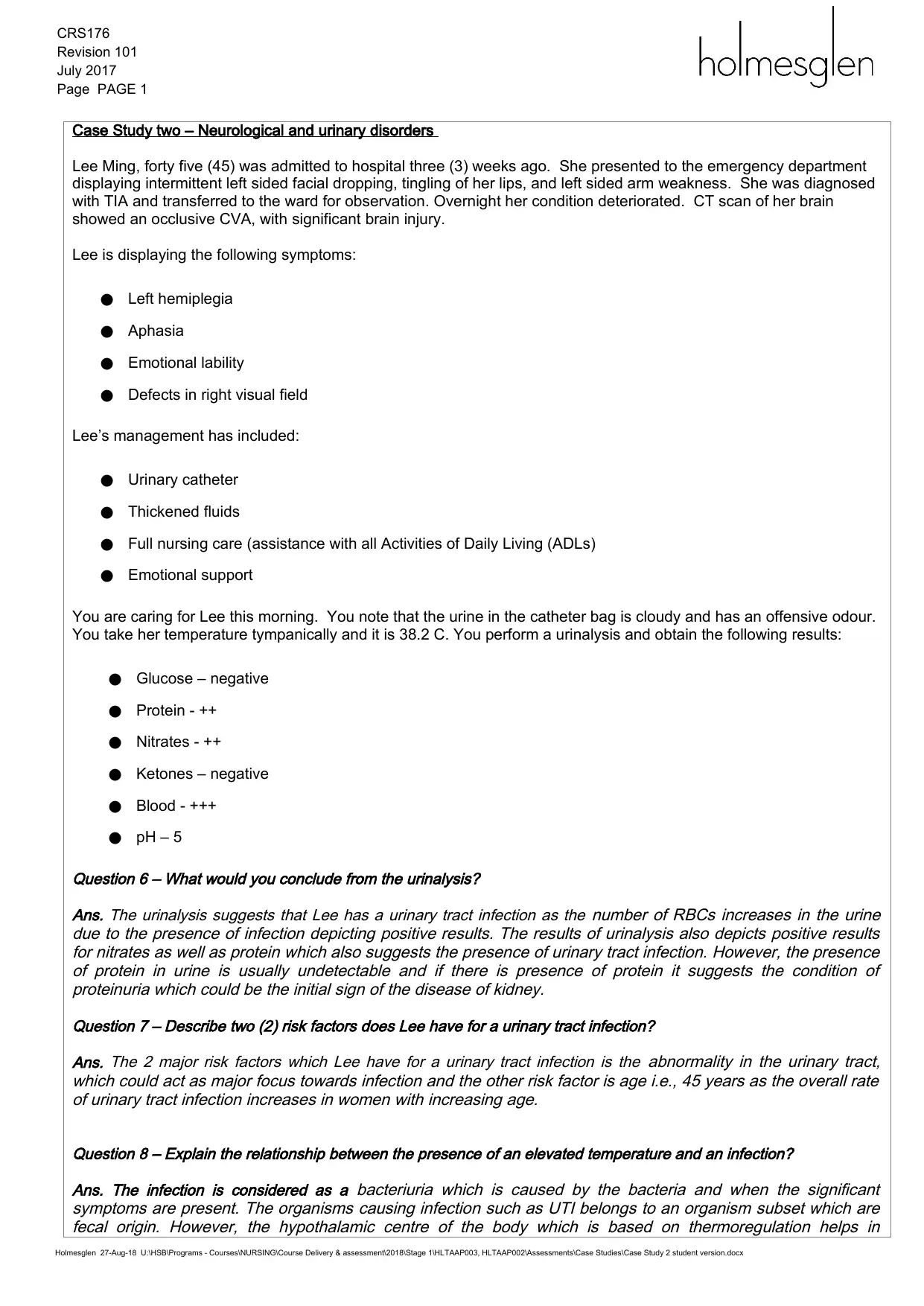
CRS176
Revision 101
July 2017
Page PAGE 1
of NUMPAGES
Case Study two – Neurological and urinary disorders
Lee Ming, forty five (45) was admitted to hospital three (3) weeks ago. She presented to the emergency department
displaying intermittent left sided facial dropping, tingling of her lips, and left sided arm weakness. She was diagnosed
with TIA and transferred to the ward for observation. Overnight her condition deteriorated. CT scan of her brain
showed an occlusive CVA, with significant brain injury.
Lee is displaying the following symptoms:
● Left hemiplegia
● Aphasia
● Emotional lability
● Defects in right visual field
Lee’s management has included:
● Urinary catheter
● Thickened fluids
● Full nursing care (assistance with all Activities of Daily Living (ADLs)
● Emotional support
You are caring for Lee this morning. You note that the urine in the catheter bag is cloudy and has an offensive odour.
You take her temperature tympanically and it is 38.2 C. You perform a urinalysis and obtain the following results:
● Glucose – negative
● Protein - ++
● Nitrates - ++
● Ketones – negative
● Blood - +++
● pH – 5
Question 6 – What would you conclude from the urinalysis?
Ans. The urinalysis suggests that Lee has a urinary tract infection as the number of RBCs increases in the urine
due to the presence of infection depicting positive results. The results of urinalysis also depicts positive results
for nitrates as well as protein which also suggests the presence of urinary tract infection. However, the presence
of protein in urine is usually undetectable and if there is presence of protein it suggests the condition of
proteinuria which could be the initial sign of the disease of kidney.
Question 7 – Describe two (2) risk factors does Lee have for a urinary tract infection?
Ans. The 2 major risk factors which Lee have for a urinary tract infection is the abnormality in the urinary tract,
which could act as major focus towards infection and the other risk factor is age i.e., 45 years as the overall rate
of urinary tract infection increases in women with increasing age.
Question 8 – Explain the relationship between the presence of an elevated temperature and an infection?
Ans. The infection is considered as a bacteriuria which is caused by the bacteria and when the significant
symptoms are present. The organisms causing infection such as UTI belongs to an organism subset which are
fecal origin. However, the hypothalamic centre of the body which is based on thermoregulation helps in
Holmesglen 27-Aug-18 U:\HSB\Programs - Courses\NURSING\Course Delivery & assessment\2018\Stage 1\HLTAAP003, HLTAAP002\Assessments\Case Studies\Case Study 2 student version.docx
Revision 101
July 2017
Page PAGE 1
of NUMPAGES
Case Study two – Neurological and urinary disorders
Lee Ming, forty five (45) was admitted to hospital three (3) weeks ago. She presented to the emergency department
displaying intermittent left sided facial dropping, tingling of her lips, and left sided arm weakness. She was diagnosed
with TIA and transferred to the ward for observation. Overnight her condition deteriorated. CT scan of her brain
showed an occlusive CVA, with significant brain injury.
Lee is displaying the following symptoms:
● Left hemiplegia
● Aphasia
● Emotional lability
● Defects in right visual field
Lee’s management has included:
● Urinary catheter
● Thickened fluids
● Full nursing care (assistance with all Activities of Daily Living (ADLs)
● Emotional support
You are caring for Lee this morning. You note that the urine in the catheter bag is cloudy and has an offensive odour.
You take her temperature tympanically and it is 38.2 C. You perform a urinalysis and obtain the following results:
● Glucose – negative
● Protein - ++
● Nitrates - ++
● Ketones – negative
● Blood - +++
● pH – 5
Question 6 – What would you conclude from the urinalysis?
Ans. The urinalysis suggests that Lee has a urinary tract infection as the number of RBCs increases in the urine
due to the presence of infection depicting positive results. The results of urinalysis also depicts positive results
for nitrates as well as protein which also suggests the presence of urinary tract infection. However, the presence
of protein in urine is usually undetectable and if there is presence of protein it suggests the condition of
proteinuria which could be the initial sign of the disease of kidney.
Question 7 – Describe two (2) risk factors does Lee have for a urinary tract infection?
Ans. The 2 major risk factors which Lee have for a urinary tract infection is the abnormality in the urinary tract,
which could act as major focus towards infection and the other risk factor is age i.e., 45 years as the overall rate
of urinary tract infection increases in women with increasing age.
Question 8 – Explain the relationship between the presence of an elevated temperature and an infection?
Ans. The infection is considered as a bacteriuria which is caused by the bacteria and when the significant
symptoms are present. The organisms causing infection such as UTI belongs to an organism subset which are
fecal origin. However, the hypothalamic centre of the body which is based on thermoregulation helps in
Holmesglen 27-Aug-18 U:\HSB\Programs - Courses\NURSING\Course Delivery & assessment\2018\Stage 1\HLTAAP003, HLTAAP002\Assessments\Case Studies\Case Study 2 student version.docx
⊘ This is a preview!⊘
Do you want full access?
Subscribe today to unlock all pages.

Trusted by 1+ million students worldwide
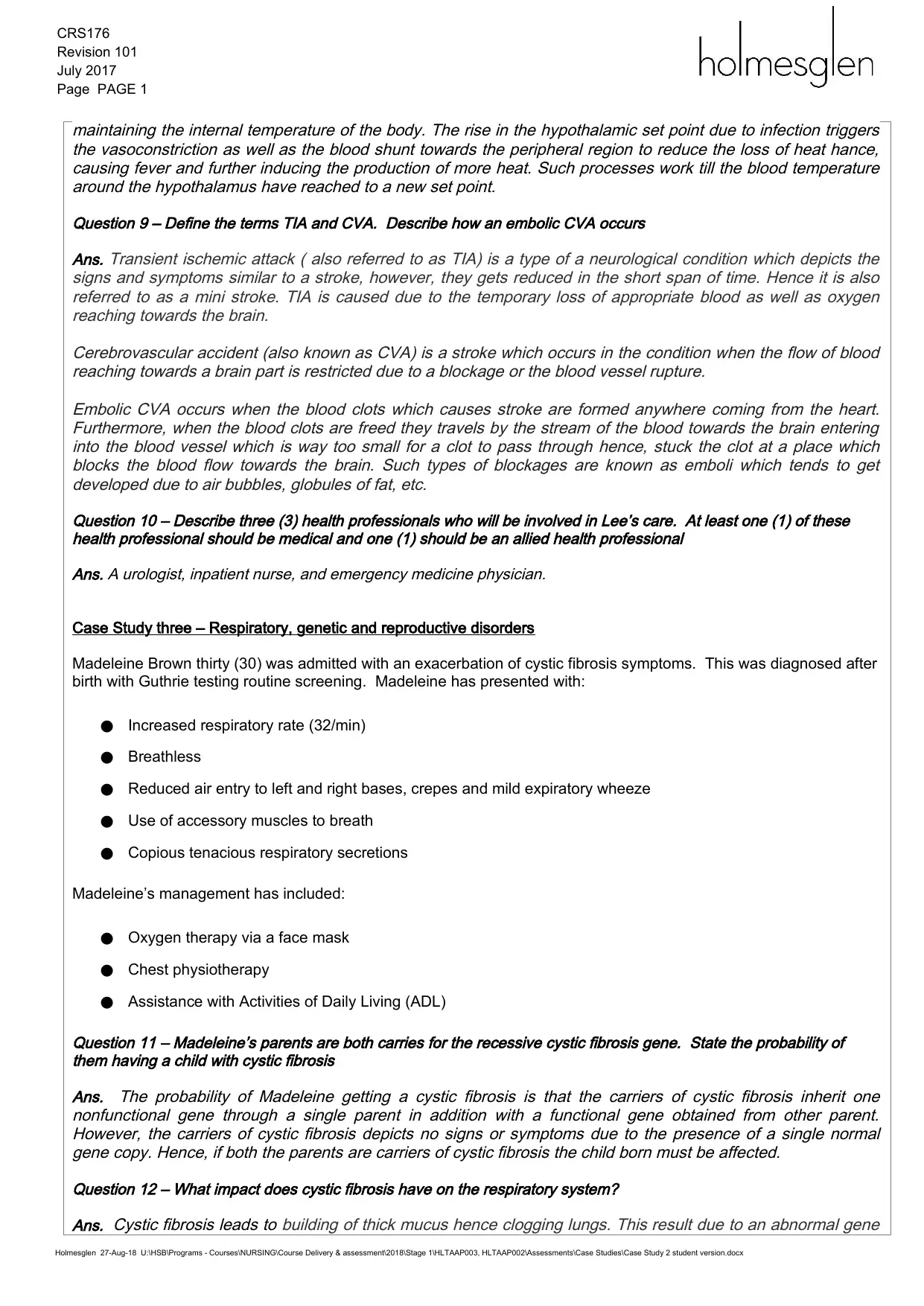
CRS176
Revision 101
July 2017
Page PAGE 1
of NUMPAGESmaintaining the internal temperature of the body. The rise in the hypothalamic set point due to infection triggers
the vasoconstriction as well as the blood shunt towards the peripheral region to reduce the loss of heat hance,
causing fever and further inducing the production of more heat. Such processes work till the blood temperature
around the hypothalamus have reached to a new set point.
Question 9 – Define the terms TIA and CVA. Describe how an embolic CVA occurs
Ans. Transient ischemic attack ( also referred to as TIA) is a type of a neurological condition which depicts the
signs and symptoms similar to a stroke, however, they gets reduced in the short span of time. Hence it is also
referred to as a mini stroke. TIA is caused due to the temporary loss of appropriate blood as well as oxygen
reaching towards the brain.
Cerebrovascular accident (also known as CVA) is a stroke which occurs in the condition when the flow of blood
reaching towards a brain part is restricted due to a blockage or the blood vessel rupture.
Embolic CVA occurs when the blood clots which causes stroke are formed anywhere coming from the heart.
Furthermore, when the blood clots are freed they travels by the stream of the blood towards the brain entering
into the blood vessel which is way too small for a clot to pass through hence, stuck the clot at a place which
blocks the blood flow towards the brain. Such types of blockages are known as emboli which tends to get
developed due to air bubbles, globules of fat, etc.
Question 10 – Describe three (3) health professionals who will be involved in Lee’s care. At least one (1) of these
health professional should be medical and one (1) should be an allied health professional
Ans. A urologist, inpatient nurse, and emergency medicine physician.
Case Study three – Respiratory, genetic and reproductive disorders
Madeleine Brown thirty (30) was admitted with an exacerbation of cystic fibrosis symptoms. This was diagnosed after
birth with Guthrie testing routine screening. Madeleine has presented with:
● Increased respiratory rate (32/min)
● Breathless
● Reduced air entry to left and right bases, crepes and mild expiratory wheeze
● Use of accessory muscles to breath
● Copious tenacious respiratory secretions
Madeleine’s management has included:
● Oxygen therapy via a face mask
● Chest physiotherapy
● Assistance with Activities of Daily Living (ADL)
Question 11 – Madeleine’s parents are both carries for the recessive cystic fibrosis gene. State the probability of
them having a child with cystic fibrosis
Ans. The probability of Madeleine getting a cystic fibrosis is that the carriers of cystic fibrosis inherit one
nonfunctional gene through a single parent in addition with a functional gene obtained from other parent.
However, the carriers of cystic fibrosis depicts no signs or symptoms due to the presence of a single normal
gene copy. Hence, if both the parents are carriers of cystic fibrosis the child born must be affected.
Question 12 – What impact does cystic fibrosis have on the respiratory system?
Ans. Cystic fibrosis leads to building of thick mucus hence clogging lungs. This result due to an abnormal gene
Holmesglen 27-Aug-18 U:\HSB\Programs - Courses\NURSING\Course Delivery & assessment\2018\Stage 1\HLTAAP003, HLTAAP002\Assessments\Case Studies\Case Study 2 student version.docx
Revision 101
July 2017
Page PAGE 1
of NUMPAGESmaintaining the internal temperature of the body. The rise in the hypothalamic set point due to infection triggers
the vasoconstriction as well as the blood shunt towards the peripheral region to reduce the loss of heat hance,
causing fever and further inducing the production of more heat. Such processes work till the blood temperature
around the hypothalamus have reached to a new set point.
Question 9 – Define the terms TIA and CVA. Describe how an embolic CVA occurs
Ans. Transient ischemic attack ( also referred to as TIA) is a type of a neurological condition which depicts the
signs and symptoms similar to a stroke, however, they gets reduced in the short span of time. Hence it is also
referred to as a mini stroke. TIA is caused due to the temporary loss of appropriate blood as well as oxygen
reaching towards the brain.
Cerebrovascular accident (also known as CVA) is a stroke which occurs in the condition when the flow of blood
reaching towards a brain part is restricted due to a blockage or the blood vessel rupture.
Embolic CVA occurs when the blood clots which causes stroke are formed anywhere coming from the heart.
Furthermore, when the blood clots are freed they travels by the stream of the blood towards the brain entering
into the blood vessel which is way too small for a clot to pass through hence, stuck the clot at a place which
blocks the blood flow towards the brain. Such types of blockages are known as emboli which tends to get
developed due to air bubbles, globules of fat, etc.
Question 10 – Describe three (3) health professionals who will be involved in Lee’s care. At least one (1) of these
health professional should be medical and one (1) should be an allied health professional
Ans. A urologist, inpatient nurse, and emergency medicine physician.
Case Study three – Respiratory, genetic and reproductive disorders
Madeleine Brown thirty (30) was admitted with an exacerbation of cystic fibrosis symptoms. This was diagnosed after
birth with Guthrie testing routine screening. Madeleine has presented with:
● Increased respiratory rate (32/min)
● Breathless
● Reduced air entry to left and right bases, crepes and mild expiratory wheeze
● Use of accessory muscles to breath
● Copious tenacious respiratory secretions
Madeleine’s management has included:
● Oxygen therapy via a face mask
● Chest physiotherapy
● Assistance with Activities of Daily Living (ADL)
Question 11 – Madeleine’s parents are both carries for the recessive cystic fibrosis gene. State the probability of
them having a child with cystic fibrosis
Ans. The probability of Madeleine getting a cystic fibrosis is that the carriers of cystic fibrosis inherit one
nonfunctional gene through a single parent in addition with a functional gene obtained from other parent.
However, the carriers of cystic fibrosis depicts no signs or symptoms due to the presence of a single normal
gene copy. Hence, if both the parents are carriers of cystic fibrosis the child born must be affected.
Question 12 – What impact does cystic fibrosis have on the respiratory system?
Ans. Cystic fibrosis leads to building of thick mucus hence clogging lungs. This result due to an abnormal gene
Holmesglen 27-Aug-18 U:\HSB\Programs - Courses\NURSING\Course Delivery & assessment\2018\Stage 1\HLTAAP003, HLTAAP002\Assessments\Case Studies\Case Study 2 student version.docx
Paraphrase This Document
Need a fresh take? Get an instant paraphrase of this document with our AI Paraphraser
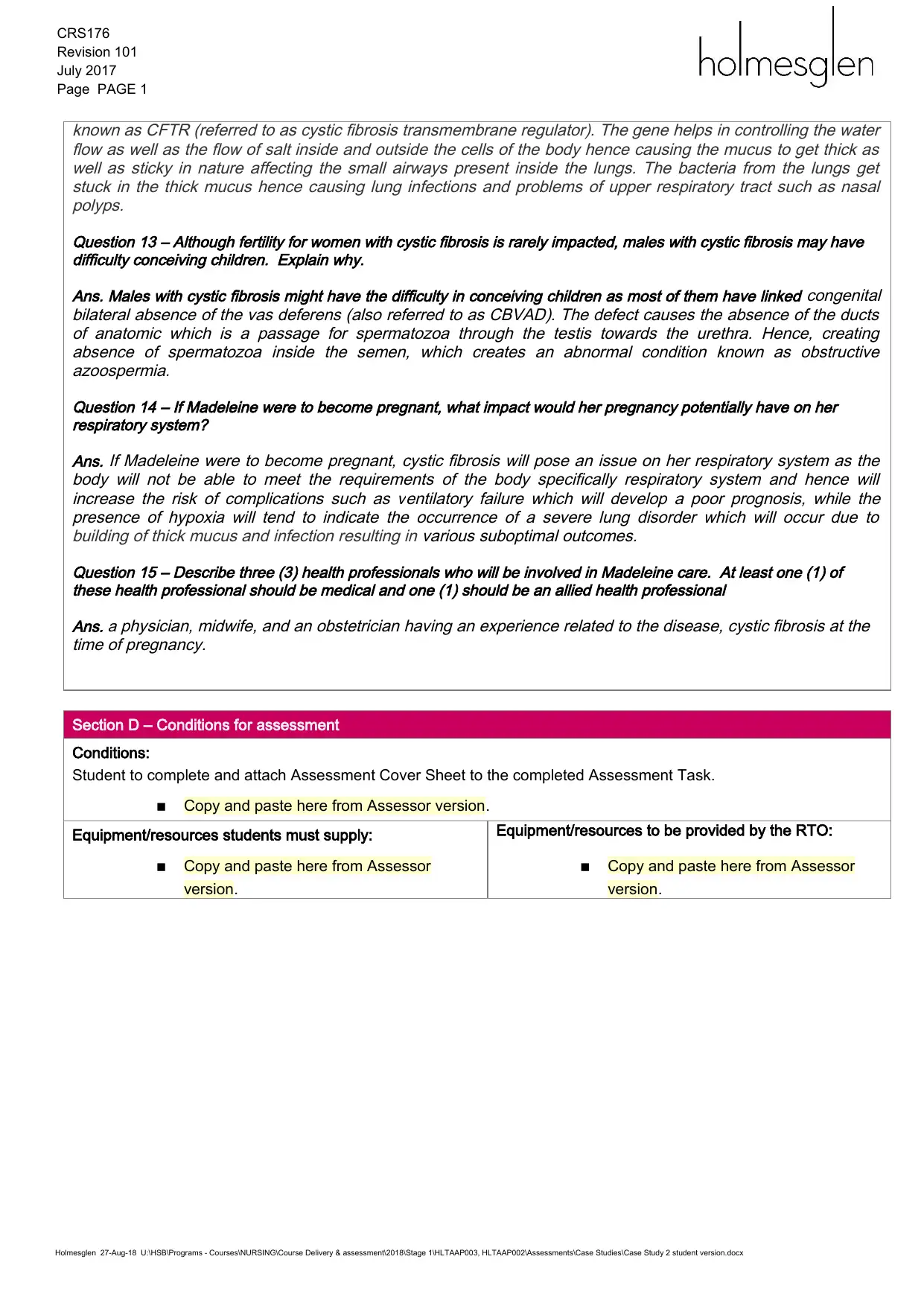
CRS176
Revision 101
July 2017
Page PAGE 1
of NUMPAGESknown as CFTR (referred to as cystic fibrosis transmembrane regulator). The gene helps in controlling the water
flow as well as the flow of salt inside and outside the cells of the body hence causing the mucus to get thick as
well as sticky in nature affecting the small airways present inside the lungs. The bacteria from the lungs get
stuck in the thick mucus hence causing lung infections and problems of upper respiratory tract such as nasal
polyps.
Question 13 – Although fertility for women with cystic fibrosis is rarely impacted, males with cystic fibrosis may have
difficulty conceiving children. Explain why.
Ans. Males with cystic fibrosis might have the difficulty in conceiving children as most of them have linked congenital
bilateral absence of the vas deferens (also referred to as CBVAD). The defect causes the absence of the ducts
of anatomic which is a passage for spermatozoa through the testis towards the urethra. Hence, creating
absence of spermatozoa inside the semen, which creates an abnormal condition known as obstructive
azoospermia.
Question 14 – If Madeleine were to become pregnant, what impact would her pregnancy potentially have on her
respiratory system?
Ans. If Madeleine were to become pregnant, cystic fibrosis will pose an issue on her respiratory system as the
body will not be able to meet the requirements of the body specifically respiratory system and hence will
increase the risk of complications such as ventilatory failure which will develop a poor prognosis, while the
presence of hypoxia will tend to indicate the occurrence of a severe lung disorder which will occur due to
building of thick mucus and infection resulting in various suboptimal outcomes.
Question 15 – Describe three (3) health professionals who will be involved in Madeleine care. At least one (1) of
these health professional should be medical and one (1) should be an allied health professional
Ans. a physician, midwife, and an obstetrician having an experience related to the disease, cystic fibrosis at the
time of pregnancy.
Section D – Conditions for assessment
Conditions:
Student to complete and attach Assessment Cover Sheet to the completed Assessment Task.
▪ Copy and paste here from Assessor version.
Equipment/resources students must supply: Equipment/resources to be provided by the RTO:
▪ Copy and paste here from Assessor
version.
▪ Copy and paste here from Assessor
version.
Holmesglen 27-Aug-18 U:\HSB\Programs - Courses\NURSING\Course Delivery & assessment\2018\Stage 1\HLTAAP003, HLTAAP002\Assessments\Case Studies\Case Study 2 student version.docx
Revision 101
July 2017
Page PAGE 1
of NUMPAGESknown as CFTR (referred to as cystic fibrosis transmembrane regulator). The gene helps in controlling the water
flow as well as the flow of salt inside and outside the cells of the body hence causing the mucus to get thick as
well as sticky in nature affecting the small airways present inside the lungs. The bacteria from the lungs get
stuck in the thick mucus hence causing lung infections and problems of upper respiratory tract such as nasal
polyps.
Question 13 – Although fertility for women with cystic fibrosis is rarely impacted, males with cystic fibrosis may have
difficulty conceiving children. Explain why.
Ans. Males with cystic fibrosis might have the difficulty in conceiving children as most of them have linked congenital
bilateral absence of the vas deferens (also referred to as CBVAD). The defect causes the absence of the ducts
of anatomic which is a passage for spermatozoa through the testis towards the urethra. Hence, creating
absence of spermatozoa inside the semen, which creates an abnormal condition known as obstructive
azoospermia.
Question 14 – If Madeleine were to become pregnant, what impact would her pregnancy potentially have on her
respiratory system?
Ans. If Madeleine were to become pregnant, cystic fibrosis will pose an issue on her respiratory system as the
body will not be able to meet the requirements of the body specifically respiratory system and hence will
increase the risk of complications such as ventilatory failure which will develop a poor prognosis, while the
presence of hypoxia will tend to indicate the occurrence of a severe lung disorder which will occur due to
building of thick mucus and infection resulting in various suboptimal outcomes.
Question 15 – Describe three (3) health professionals who will be involved in Madeleine care. At least one (1) of
these health professional should be medical and one (1) should be an allied health professional
Ans. a physician, midwife, and an obstetrician having an experience related to the disease, cystic fibrosis at the
time of pregnancy.
Section D – Conditions for assessment
Conditions:
Student to complete and attach Assessment Cover Sheet to the completed Assessment Task.
▪ Copy and paste here from Assessor version.
Equipment/resources students must supply: Equipment/resources to be provided by the RTO:
▪ Copy and paste here from Assessor
version.
▪ Copy and paste here from Assessor
version.
Holmesglen 27-Aug-18 U:\HSB\Programs - Courses\NURSING\Course Delivery & assessment\2018\Stage 1\HLTAAP003, HLTAAP002\Assessments\Case Studies\Case Study 2 student version.docx
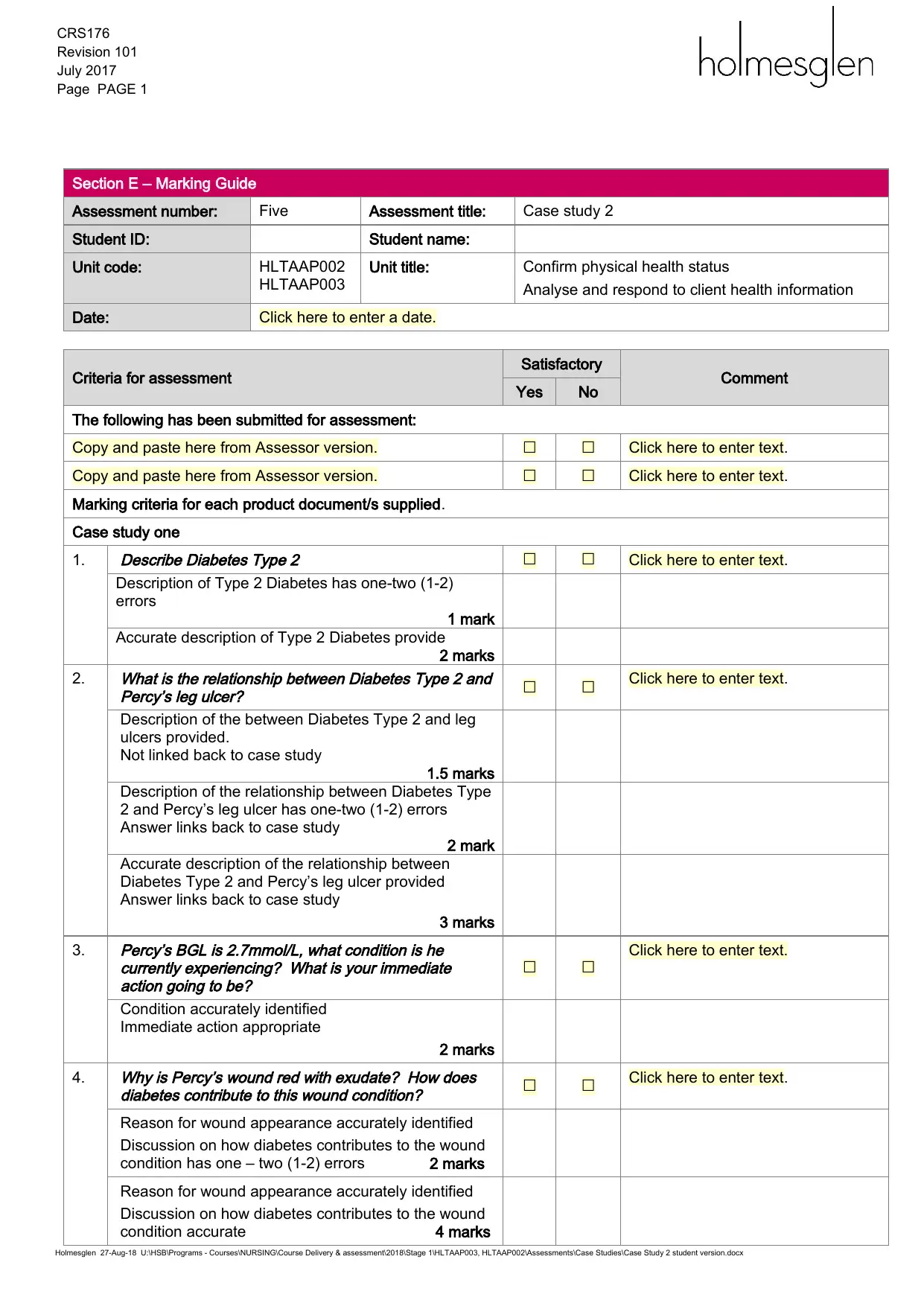
CRS176
Revision 101
July 2017
Page PAGE 1
of NUMPAGES
Section E – Marking Guide
Assessment number: Five Assessment title: Case study 2
Student ID: Student name:
Unit code: HLTAAP002
HLTAAP003
Unit title: Confirm physical health status
Analyse and respond to client health information
Date: Click here to enter a date.
Criteria for assessment Satisfactory Comment
Yes No
The following has been submitted for assessment:
Copy and paste here from Assessor version. ☐ ☐ Click here to enter text.
Copy and paste here from Assessor version. ☐ ☐ Click here to enter text.
Marking criteria for each product document/s supplied.
Case study one
1.
Describe Diabetes Type 2 ☐ ☐ Click here to enter text.
Description of Type 2 Diabetes has one-two (1-2)
errors
1 mark
Accurate description of Type 2 Diabetes provide
2 marks
2.
What is the relationship between Diabetes Type 2 and
Percy’s leg ulcer? ☐ ☐ Click here to enter text.
Description of the between Diabetes Type 2 and leg
ulcers provided.
Not linked back to case study
1.5 marks
Description of the relationship between Diabetes Type
2 and Percy’s leg ulcer has one-two (1-2) errors
Answer links back to case study
2 mark
Accurate description of the relationship between
Diabetes Type 2 and Percy’s leg ulcer provided
Answer links back to case study
3 marks
3.
Percy’s BGL is 2.7mmol/L, what condition is he
currently experiencing? What is your immediate
action going to be?
☐ ☐
Click here to enter text.
Condition accurately identified
Immediate action appropriate
2 marks
4.
Why is Percy’s wound red with exudate? How does
diabetes contribute to this wound condition? ☐ ☐ Click here to enter text.
Reason for wound appearance accurately identified
Discussion on how diabetes contributes to the wound
condition has one – two (1-2) errors 2 marks
Reason for wound appearance accurately identified
Discussion on how diabetes contributes to the wound
condition accurate 4 marks
Holmesglen 27-Aug-18 U:\HSB\Programs - Courses\NURSING\Course Delivery & assessment\2018\Stage 1\HLTAAP003, HLTAAP002\Assessments\Case Studies\Case Study 2 student version.docx
Revision 101
July 2017
Page PAGE 1
of NUMPAGES
Section E – Marking Guide
Assessment number: Five Assessment title: Case study 2
Student ID: Student name:
Unit code: HLTAAP002
HLTAAP003
Unit title: Confirm physical health status
Analyse and respond to client health information
Date: Click here to enter a date.
Criteria for assessment Satisfactory Comment
Yes No
The following has been submitted for assessment:
Copy and paste here from Assessor version. ☐ ☐ Click here to enter text.
Copy and paste here from Assessor version. ☐ ☐ Click here to enter text.
Marking criteria for each product document/s supplied.
Case study one
1.
Describe Diabetes Type 2 ☐ ☐ Click here to enter text.
Description of Type 2 Diabetes has one-two (1-2)
errors
1 mark
Accurate description of Type 2 Diabetes provide
2 marks
2.
What is the relationship between Diabetes Type 2 and
Percy’s leg ulcer? ☐ ☐ Click here to enter text.
Description of the between Diabetes Type 2 and leg
ulcers provided.
Not linked back to case study
1.5 marks
Description of the relationship between Diabetes Type
2 and Percy’s leg ulcer has one-two (1-2) errors
Answer links back to case study
2 mark
Accurate description of the relationship between
Diabetes Type 2 and Percy’s leg ulcer provided
Answer links back to case study
3 marks
3.
Percy’s BGL is 2.7mmol/L, what condition is he
currently experiencing? What is your immediate
action going to be?
☐ ☐
Click here to enter text.
Condition accurately identified
Immediate action appropriate
2 marks
4.
Why is Percy’s wound red with exudate? How does
diabetes contribute to this wound condition? ☐ ☐ Click here to enter text.
Reason for wound appearance accurately identified
Discussion on how diabetes contributes to the wound
condition has one – two (1-2) errors 2 marks
Reason for wound appearance accurately identified
Discussion on how diabetes contributes to the wound
condition accurate 4 marks
Holmesglen 27-Aug-18 U:\HSB\Programs - Courses\NURSING\Course Delivery & assessment\2018\Stage 1\HLTAAP003, HLTAAP002\Assessments\Case Studies\Case Study 2 student version.docx
⊘ This is a preview!⊘
Do you want full access?
Subscribe today to unlock all pages.

Trusted by 1+ million students worldwide
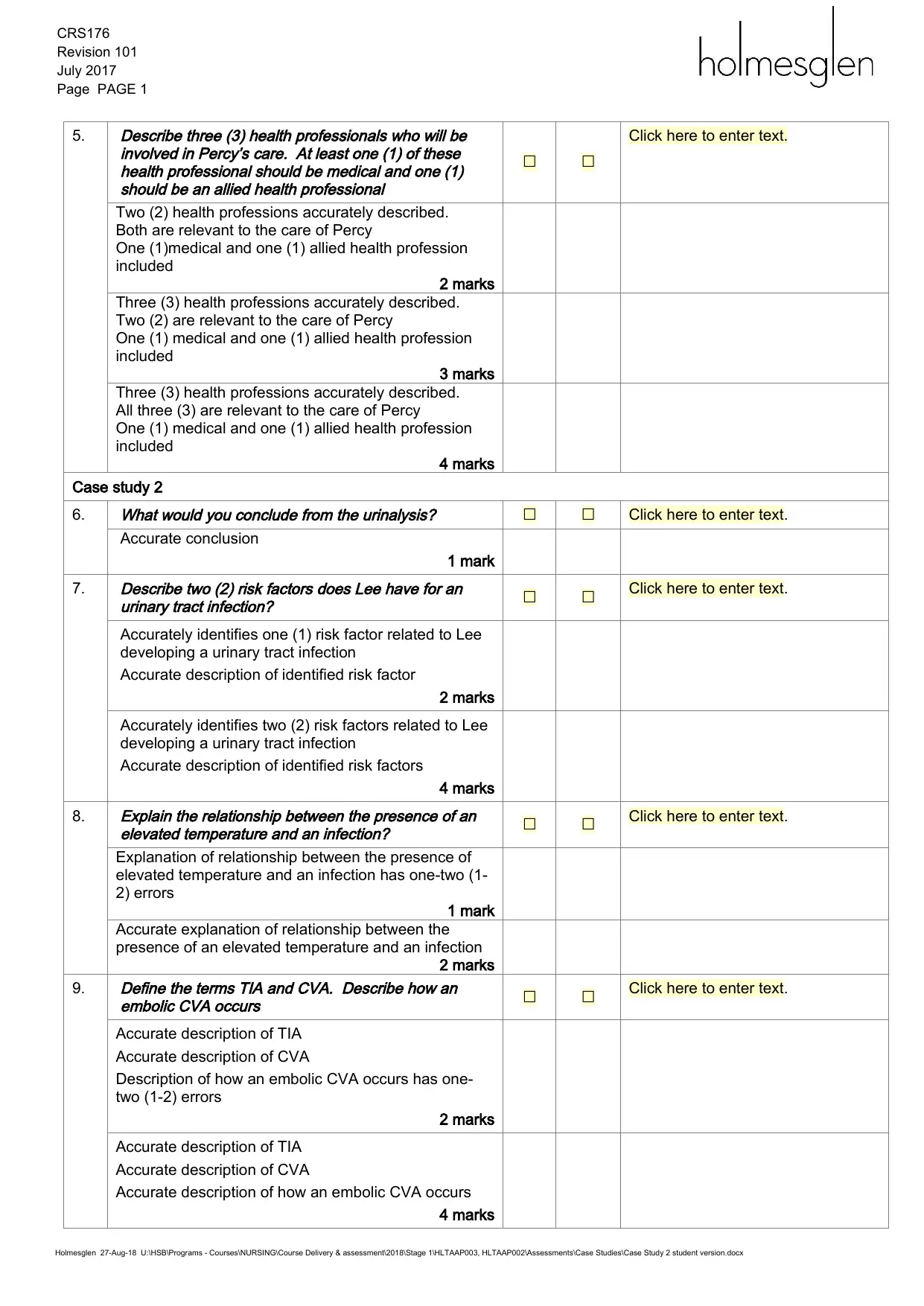
CRS176
Revision 101
July 2017
Page PAGE 1
of NUMPAGES
5.
Describe three (3) health professionals who will be
involved in Percy’s care. At least one (1) of these
health professional should be medical and one (1)
should be an allied health professional
☐ ☐
Click here to enter text.
Two (2) health professions accurately described.
Both are relevant to the care of Percy
One (1)medical and one (1) allied health profession
included
2 marks
Three (3) health professions accurately described.
Two (2) are relevant to the care of Percy
One (1) medical and one (1) allied health profession
included
3 marks
Three (3) health professions accurately described.
All three (3) are relevant to the care of Percy
One (1) medical and one (1) allied health profession
included
4 marks
Case study 2
6.
What would you conclude from the urinalysis? ☐ ☐ Click here to enter text.
Accurate conclusion
1 mark
7.
Describe two (2) risk factors does Lee have for an
urinary tract infection? ☐ ☐ Click here to enter text.
Accurately identifies one (1) risk factor related to Lee
developing a urinary tract infection
Accurate description of identified risk factor
2 marks
Accurately identifies two (2) risk factors related to Lee
developing a urinary tract infection
Accurate description of identified risk factors
4 marks
8.
Explain the relationship between the presence of an
elevated temperature and an infection? ☐ ☐ Click here to enter text.
Explanation of relationship between the presence of
elevated temperature and an infection has one-two (1-
2) errors
1 mark
Accurate explanation of relationship between the
presence of an elevated temperature and an infection
2 marks
9.
Define the terms TIA and CVA. Describe how an
embolic CVA occurs ☐ ☐ Click here to enter text.
Accurate description of TIA
Accurate description of CVA
Description of how an embolic CVA occurs has one-
two (1-2) errors
2 marks
Accurate description of TIA
Accurate description of CVA
Accurate description of how an embolic CVA occurs
4 marks
Holmesglen 27-Aug-18 U:\HSB\Programs - Courses\NURSING\Course Delivery & assessment\2018\Stage 1\HLTAAP003, HLTAAP002\Assessments\Case Studies\Case Study 2 student version.docx
Revision 101
July 2017
Page PAGE 1
of NUMPAGES
5.
Describe three (3) health professionals who will be
involved in Percy’s care. At least one (1) of these
health professional should be medical and one (1)
should be an allied health professional
☐ ☐
Click here to enter text.
Two (2) health professions accurately described.
Both are relevant to the care of Percy
One (1)medical and one (1) allied health profession
included
2 marks
Three (3) health professions accurately described.
Two (2) are relevant to the care of Percy
One (1) medical and one (1) allied health profession
included
3 marks
Three (3) health professions accurately described.
All three (3) are relevant to the care of Percy
One (1) medical and one (1) allied health profession
included
4 marks
Case study 2
6.
What would you conclude from the urinalysis? ☐ ☐ Click here to enter text.
Accurate conclusion
1 mark
7.
Describe two (2) risk factors does Lee have for an
urinary tract infection? ☐ ☐ Click here to enter text.
Accurately identifies one (1) risk factor related to Lee
developing a urinary tract infection
Accurate description of identified risk factor
2 marks
Accurately identifies two (2) risk factors related to Lee
developing a urinary tract infection
Accurate description of identified risk factors
4 marks
8.
Explain the relationship between the presence of an
elevated temperature and an infection? ☐ ☐ Click here to enter text.
Explanation of relationship between the presence of
elevated temperature and an infection has one-two (1-
2) errors
1 mark
Accurate explanation of relationship between the
presence of an elevated temperature and an infection
2 marks
9.
Define the terms TIA and CVA. Describe how an
embolic CVA occurs ☐ ☐ Click here to enter text.
Accurate description of TIA
Accurate description of CVA
Description of how an embolic CVA occurs has one-
two (1-2) errors
2 marks
Accurate description of TIA
Accurate description of CVA
Accurate description of how an embolic CVA occurs
4 marks
Holmesglen 27-Aug-18 U:\HSB\Programs - Courses\NURSING\Course Delivery & assessment\2018\Stage 1\HLTAAP003, HLTAAP002\Assessments\Case Studies\Case Study 2 student version.docx
Paraphrase This Document
Need a fresh take? Get an instant paraphrase of this document with our AI Paraphraser
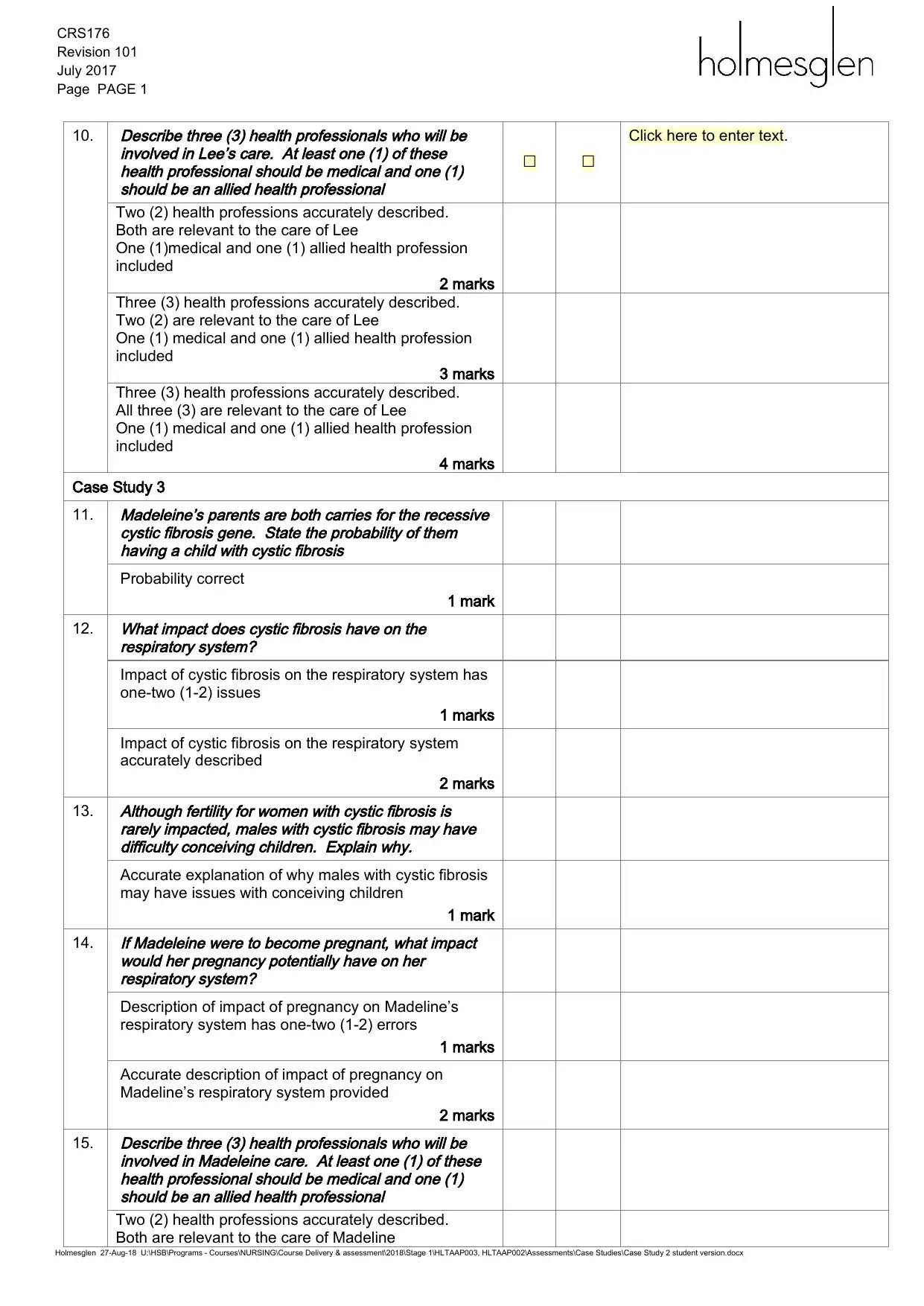
CRS176
Revision 101
July 2017
Page PAGE 1
of NUMPAGES
10.
Describe three (3) health professionals who will be
involved in Lee’s care. At least one (1) of these
health professional should be medical and one (1)
should be an allied health professional
☐ ☐
Click here to enter text.
Two (2) health professions accurately described.
Both are relevant to the care of Lee
One (1)medical and one (1) allied health profession
included
2 marks
Three (3) health professions accurately described.
Two (2) are relevant to the care of Lee
One (1) medical and one (1) allied health profession
included
3 marks
Three (3) health professions accurately described.
All three (3) are relevant to the care of Lee
One (1) medical and one (1) allied health profession
included
4 marks
Case Study 3
11.
Madeleine’s parents are both carries for the recessive
cystic fibrosis gene. State the probability of them
having a child with cystic fibrosis
Probability correct
1 mark
12.
What impact does cystic fibrosis have on the
respiratory system?
Impact of cystic fibrosis on the respiratory system has
one-two (1-2) issues
1 marks
Impact of cystic fibrosis on the respiratory system
accurately described
2 marks
13.
Although fertility for women with cystic fibrosis is
rarely impacted, males with cystic fibrosis may have
difficulty conceiving children. Explain why.
Accurate explanation of why males with cystic fibrosis
may have issues with conceiving children
1 mark
14.
If Madeleine were to become pregnant, what impact
would her pregnancy potentially have on her
respiratory system?
Description of impact of pregnancy on Madeline’s
respiratory system has one-two (1-2) errors
1 marks
Accurate description of impact of pregnancy on
Madeline’s respiratory system provided
2 marks
15.
Describe three (3) health professionals who will be
involved in Madeleine care. At least one (1) of these
health professional should be medical and one (1)
should be an allied health professional
Two (2) health professions accurately described.
Both are relevant to the care of Madeline
Holmesglen 27-Aug-18 U:\HSB\Programs - Courses\NURSING\Course Delivery & assessment\2018\Stage 1\HLTAAP003, HLTAAP002\Assessments\Case Studies\Case Study 2 student version.docx
Revision 101
July 2017
Page PAGE 1
of NUMPAGES
10.
Describe three (3) health professionals who will be
involved in Lee’s care. At least one (1) of these
health professional should be medical and one (1)
should be an allied health professional
☐ ☐
Click here to enter text.
Two (2) health professions accurately described.
Both are relevant to the care of Lee
One (1)medical and one (1) allied health profession
included
2 marks
Three (3) health professions accurately described.
Two (2) are relevant to the care of Lee
One (1) medical and one (1) allied health profession
included
3 marks
Three (3) health professions accurately described.
All three (3) are relevant to the care of Lee
One (1) medical and one (1) allied health profession
included
4 marks
Case Study 3
11.
Madeleine’s parents are both carries for the recessive
cystic fibrosis gene. State the probability of them
having a child with cystic fibrosis
Probability correct
1 mark
12.
What impact does cystic fibrosis have on the
respiratory system?
Impact of cystic fibrosis on the respiratory system has
one-two (1-2) issues
1 marks
Impact of cystic fibrosis on the respiratory system
accurately described
2 marks
13.
Although fertility for women with cystic fibrosis is
rarely impacted, males with cystic fibrosis may have
difficulty conceiving children. Explain why.
Accurate explanation of why males with cystic fibrosis
may have issues with conceiving children
1 mark
14.
If Madeleine were to become pregnant, what impact
would her pregnancy potentially have on her
respiratory system?
Description of impact of pregnancy on Madeline’s
respiratory system has one-two (1-2) errors
1 marks
Accurate description of impact of pregnancy on
Madeline’s respiratory system provided
2 marks
15.
Describe three (3) health professionals who will be
involved in Madeleine care. At least one (1) of these
health professional should be medical and one (1)
should be an allied health professional
Two (2) health professions accurately described.
Both are relevant to the care of Madeline
Holmesglen 27-Aug-18 U:\HSB\Programs - Courses\NURSING\Course Delivery & assessment\2018\Stage 1\HLTAAP003, HLTAAP002\Assessments\Case Studies\Case Study 2 student version.docx
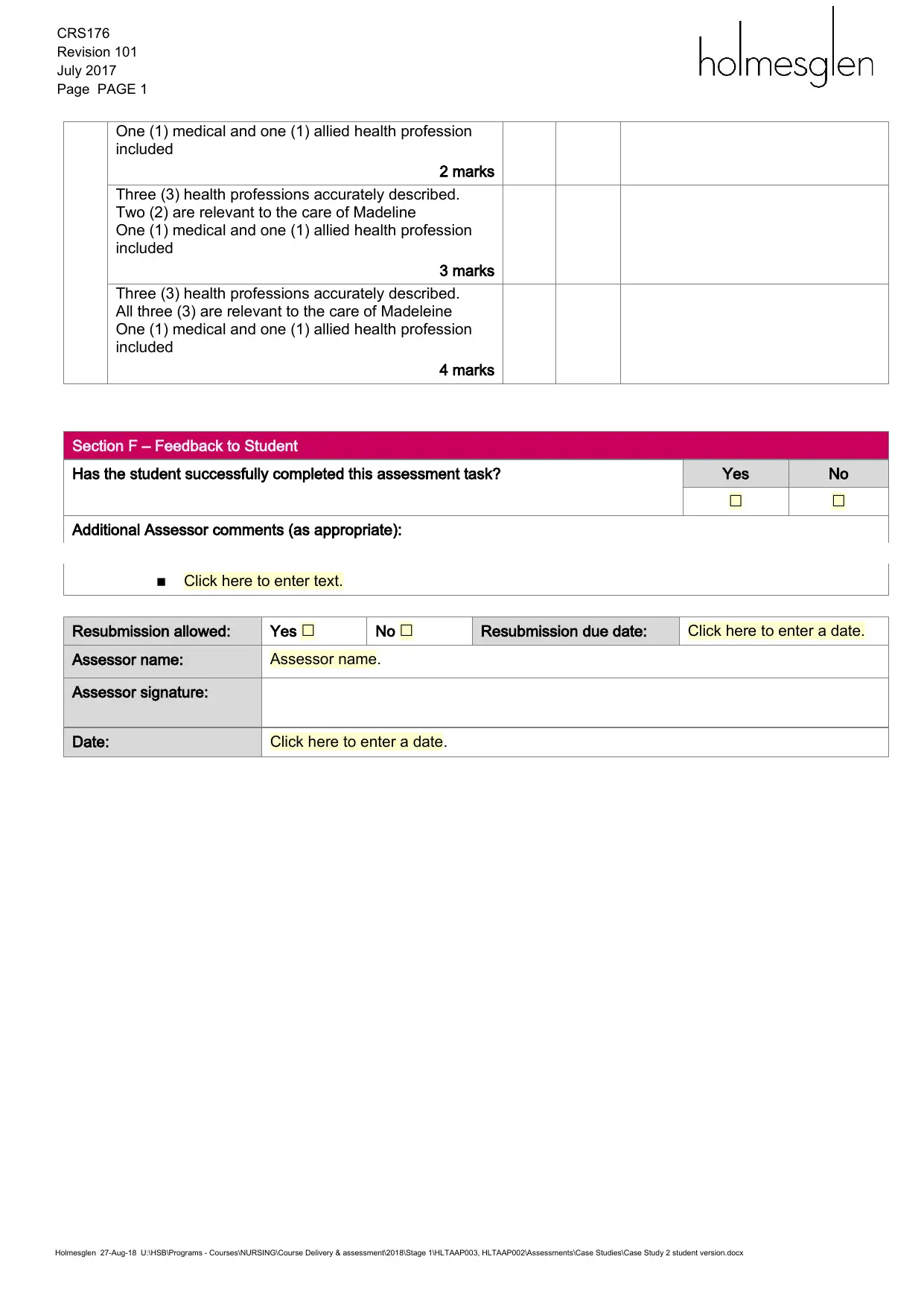
CRS176
Revision 101
July 2017
Page PAGE 1
of NUMPAGES
One (1) medical and one (1) allied health profession
included
2 marks
Three (3) health professions accurately described.
Two (2) are relevant to the care of Madeline
One (1) medical and one (1) allied health profession
included
3 marks
Three (3) health professions accurately described.
All three (3) are relevant to the care of Madeleine
One (1) medical and one (1) allied health profession
included
4 marks
Section F – Feedback to Student
Has the student successfully completed this assessment task? Yes No
☐ ☐
Additional Assessor comments (as appropriate):
▪ Click here to enter text.
Resubmission allowed: Yes ☐ No ☐ Resubmission due date: Click here to enter a date.
Assessor name: Assessor name.
Assessor signature:
Date: Click here to enter a date.
Holmesglen 27-Aug-18 U:\HSB\Programs - Courses\NURSING\Course Delivery & assessment\2018\Stage 1\HLTAAP003, HLTAAP002\Assessments\Case Studies\Case Study 2 student version.docx
Revision 101
July 2017
Page PAGE 1
of NUMPAGES
One (1) medical and one (1) allied health profession
included
2 marks
Three (3) health professions accurately described.
Two (2) are relevant to the care of Madeline
One (1) medical and one (1) allied health profession
included
3 marks
Three (3) health professions accurately described.
All three (3) are relevant to the care of Madeleine
One (1) medical and one (1) allied health profession
included
4 marks
Section F – Feedback to Student
Has the student successfully completed this assessment task? Yes No
☐ ☐
Additional Assessor comments (as appropriate):
▪ Click here to enter text.
Resubmission allowed: Yes ☐ No ☐ Resubmission due date: Click here to enter a date.
Assessor name: Assessor name.
Assessor signature:
Date: Click here to enter a date.
Holmesglen 27-Aug-18 U:\HSB\Programs - Courses\NURSING\Course Delivery & assessment\2018\Stage 1\HLTAAP003, HLTAAP002\Assessments\Case Studies\Case Study 2 student version.docx
⊘ This is a preview!⊘
Do you want full access?
Subscribe today to unlock all pages.

Trusted by 1+ million students worldwide
1 out of 9
Related Documents
Your All-in-One AI-Powered Toolkit for Academic Success.
+13062052269
info@desklib.com
Available 24*7 on WhatsApp / Email
![[object Object]](/_next/static/media/star-bottom.7253800d.svg)
Unlock your academic potential
Copyright © 2020–2025 A2Z Services. All Rights Reserved. Developed and managed by ZUCOL.





